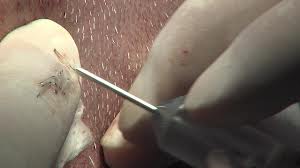Hair transplantation is an historic procedure that is done very much today as it was decades ago. While the number of grafts transplanted in a single session has increased over the years, from a few hundred to thousands in a single session, the fundamental concept of moving individual hairs from the back or sides of the head to the top has not changed. (and probably never will) One of the major advancements has been the change from large circular plugs that contain many hairs to single or double hair units that create a more natural appearance and hairlines.
But no matter how many hair units are transferred and the location to which they are implanted, they must be harvested. Until the day comes when one’s individual hair follicles can be grown in cell culture and then used as transplants, the patient must be their own ‘recycling’ center. The standard method of donor site hair harvest has been the strip method. But cutting out a strip of hair along the back of the head, hairs can be cut out from the skin strip and prepared for transplantation. While effective, this creates a donor scar that may or may not create a favorable scar. For many men, trade-off of a scalp scar for having more hair on the top of the head may be a risky decision.



Neograft has been touted as a ‘game changer’ in hair transplantation surgery. And it is but not because it makes hair transplantation faster, more effective, or cheaper. It does so because it eliminates the donor scar. That may seem to be a trivial issue but it is a major consideration for many potential hair transplantation patient.s As I always tell my cosmetic surgery patients for any procedure, it is all about trading off one problem for another. Every cosmetic procedure has trade-offs (some major and some minor) so you had better like and be accepting of whatever the trade-offs are. When a long scar exists across the back of your head that will be a major aesthetic issue if one ever decides that they need or want to wear short hair or have a buzz cut. (and some hair transplant patients do end up making that decision based on their genetic predisposition to balding and the quality of their hair transplant result) Neograft ‘s minimally invasive approach to harvest now makes that a safer decision and one never ends up in a worse place with the appearance of their scalp no matter how their hair transplant result turns out.
Dr. Barry Eppley
Indianapolis, Indiana


